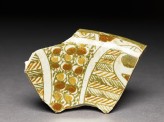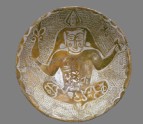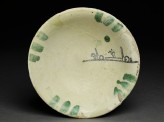Islamic Ceramics trail
Explore over one thousand years of development in Islamic ceramics through our extensive collection.
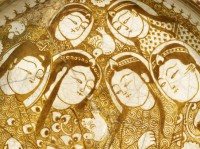
- This is a visual browsing tool that maps objects in this publication, gallery or collection trail by date of creation onto a timeline.
- The circular markers indicate where objects are on the timeline.
- The size of the markers indicates the relative number of objects at that point on the timeline.
- Hover over a marker to find out which objects are represented at that point in time.
- To expand, collapse or hide the timeline, click these symbols
 found at the top right of the timeline.
found at the top right of the timeline.
- 780
- 820
- 860
- 900
- 940
- 980
- 1020
- 1060
- 1100
- 1140
- 1180
- 1220
- 1260
- 1300
- 1340
- 1380
- 1420
- 1460
- 1500
- 1540
- 1580
- 1620
Extraordinary developments in the production of glazed ceramics took place in the Middle East during the 9th century AD.
Stimulated by the arrival on the Middle Eastern markets of high-fired white ware from China, local potters began to experiment with a new kind of glazed ware which could compete with highly-prized Chinese imports. The result was a class of soft earthenware vessels covered in an opaque white glaze, obtained by a successful combination of tin and lead oxides in the glaze mixture.
New opportunities
Middle Eastern potters quickly realised the potential of this new glaze, which could act as a base for different kinds of decoration. The finest examples were made in Iraq, where the port city of Basra has been identified as the main centre of production. Initially, Iraqi potters painted the white surface of their vessels with vegetal, geometric and calligraphic decoration in blue using cobalt oxide imported from the Arabian Peninsula. They occasionally added splashes of green to this blue-and-white scheme.
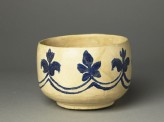 Mortar-shaped bowl with vegetal decoration (EA1978.2137)
Mortar-shaped bowl with vegetal decoration (EA1978.2137)
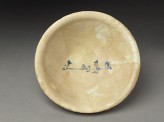 Bowl with epigraphic decoration (EA1978.2138)
Bowl with epigraphic decoration (EA1978.2138)
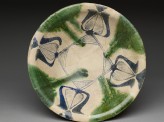 Bowl with blue and green decoration (EA1978.2141)
Bowl with blue and green decoration (EA1978.2141)
Lustre painting
During this period, Iraqi potters were responsible for another major technological achievement: the development of lustre painting on ceramics. Lustre was already known in the glass-making industry, but it was brought to its full potential on ceramics. Potters applied metal oxides to the opaque white surface of ceramics which had already been fired. These pieces were then fired a second time in a kiln with low oxygen levels. At the end of this process, made more risky and expensive by the double firing, the painted decoration assumed a distinctive metallic sheen.
Over the second half of the century, the lustre palette was refined with potters using a single colour instead of a multi-coloured scheme. A parallel change can be seen in the nature of the decoration, which became increasingly figural.
Iraqi potters seem to have held the monopoly in both cobalt and lustre painting. In contrast, the newly developed tin glaze rapidly spread across the Islamic lands, eventually reaching Europe. By the following century, opaque white ware with painted decoration in green, yellow, and brown were being made from North Africa to Central Asia.
References
Allan, James W., Islamic ceramics, Ashmolean - Christie's Handbooks (Oxford: Ashmolean Museum, 1991), pp. 6-7 and pp. 8-9
© 2013 University of Oxford - Ashmolean Museum

